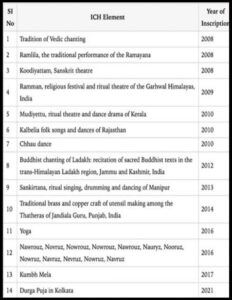GUJARAT’S GARBA ENTERS UNESCO INTANGIBLE CULTURAL HERITAGE LIST
Why in the News?
- UNESCO has officially included Gujarat’s traditional dance, ‘Garba,’ in its esteemed list of Intangible Cultural Heritage.
- This recognition marks the 15th cultural element from India to receive acknowledgment from UNESCO.
2003 Convention Recognition:
- The inclusion of Garba aligns with the provisions outlined in the 2003 Convention for the Safeguarding of Intangible Cultural Heritage.
Already Existing Arts in the list
About Garba
- Origin and Occasion: Garba is a traditional dance form originating from Gujarat. It is a significant part of the nine-day Hindu festival Navarātrī.
- Meaning of ‘Garba’:The term “Garba” is derived from Sanskrit, signifying “womb” and connoting gestation or pregnancy, symbolizing life.
- Symbolism with a Womb Lamp:
- During the dance, participants move around a clay lantern with a lit interior, known as Garbha Deep or “womb lamp.”
- This lantern symbolizes life, specifically the fetus in the womb, and serves as a representation of Durga, the feminine divine.
- Circular Performance Reflecting Life Cycle:Traditionally performed in a circular arrangement, symbolizing the cyclical nature of birth, life, death, and rebirth, with the stationary Goddess idol as a constant presence.
- Honouring the Feminine Divine:Participants engage in the dance to pay homage to Durga, embracing the feminine form of divinity. The circular dance and symbolism emphasize the eternal nature of the Goddess amid life’s cycles.
About UNESCO Intangible Cultural Heritage List
- UNESCO created Lists of Intangible Cultural Heritage to protect global intangible cultural heritages.
- The Intergovernmental Committee for Safeguarding manages and publishes this list.
- Committee members are elected by State Parties during a General Assembly.
- The goal is to raise awareness and ensure the preservation of significant cultural elements.




